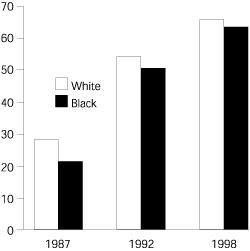
Am Fam Physician. 2003;67(5):1104-1106
The incidence of breast cancer is slightly lower in black women than in white women in the United States. However, the mortality rate is higher in blacks, and this gap is increasing. While mortality rates for breast cancer in white women have decreased by about 2 percent per year for the past decade, rates in black women have been stable for much of this time. Although most of the difference in mortality rates is attributed to presentation at a relatively advanced stage, survival at each stage also is lower among black women. Lannin and colleagues examined explanations for disparities in the rates of breast cancer survival with a view to developing intervention strategies.
The authors first examined differences in uptake of mammography screening services. Because of several concerted community interventions, the disparity between white and black women's use of mammography has diminished, and more than 60 percent of all women 40 years or older have had mammography within the past year (see the accompanying figure). Programs that have been the most successful in increasing mammography screening uptake among low-income black women have used lay health advisors chosen from women in their community to whom others turn for advice and support. Black women also tend to accord great importance to physician recommendations. Ensuring that physicians arrange screening mammography for all appropriate black women appears pivotal to reducing breast cancer mortality in this group.

Even when economic and health care access issues are accounted for, racial differences remain in the stage at diagnosis and outcomes of treatment for breast cancer. The authors surveyed 1,500 women (54 percent white and 46 percent black) about their attitudes and beliefs concerning breast cancer (see the accompanying table). Among the results of this survey, blacks were more likely than whites to report a reliance on God to cure cancer without medical intervention, fatalism that medical and especially surgical treatment would be futile, a specific belief that surgery makes cancer spread more quickly, belief that a painless lump cannot be cancer, and reliance on alternative therapies. Blacks also were much less confident about support from male partners, and 30 percent reported that a man would probably leave a woman who had a breast removed.
The authors conclude that black and white women see the world differently and interpret cancer and its treatment in the context of cultural beliefs. While these beliefs might cause women to avoid screening, this could be overcome by appropriate counseling from community members and especially from physicians. Actions on discovering a lump and decisions about participating in therapy are much more complex. The authors urge physicians to learn more about the beliefs of black women and to address these beliefs specifically in developing treatment strategies that can be effective.